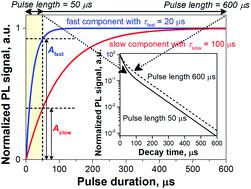当前位置:
X-MOL 学术
›
Faraday Discuss.
›
论文详情
Our official English website, www.x-mol.net, welcomes your
feedback! (Note: you will need to create a separate account there.)
Power-dependent photoluminescence decay kinetics of silicon nanocrystals under continuous and pulsed excitation.
Faraday Discussions ( IF 3.3 ) Pub Date : 2019-11-01 , DOI: 10.1039/c9fd00100j Michael Greben 1 , Jan Valenta
Faraday Discussions ( IF 3.3 ) Pub Date : 2019-11-01 , DOI: 10.1039/c9fd00100j Michael Greben 1 , Jan Valenta
Affiliation

|
Power-dependent photoluminescence (PL) decay kinetics of silicon nanocrystals (Si NCs) in solid and liquid samples were studied under cw and pulsed excitation. The lifetime distribution and, consequently the measured PL kinetics are shown to depend on the excitation pulse duration until it is not sufficiently short (pulsed limit) or long (cw limit). These two excitation limits, however, are proven to excite different distributions of lifetime components and cannot be directly compared. We derive and experimentally confirm the equality of lifetimes averaged over amplitude and intensity for cw and pulsed excitation, accordingly. The absorption cross section (ACS) of Si NCs in solid and liquid samples is assessed and compared by two approaches under cw-excitation based on the treatment of power-modulated PL kinetics or PL amplitude saturation curves under low and moderate excitation powers, respectively. The discrepancy in extracted ACS values as well as the long-debated phenomena of incomplete PL saturation of matrix-embedded Si NCs is explained by a proposed model that is based on saturation of various components in an ensemble distribution at different excitation powers. The model finally allows us to explain the mystery of average decay lifetime dependence on excitation power in the non-linear power regime. By varying the excitation from cw to pulsed, we showed the reduction of average decay lifetime in the later case and attribute this to the increased relative PL contribution of fast lifetime components that results in at least one order of magnitude lower ACS values. Finally, exciting the solid sample with very high excitation powers, we detected a PL intensity decrease region that allowed us to extract the Auger lifetime which is about 170 ns.
中文翻译:

连续和脉冲激发下硅纳米晶体的功率相关光致发光衰减动力学。
在连续波和脉冲激发下研究了固体和液体样品中硅纳米晶体(Si NCs)的功率相关光致发光(PL)衰减动力学。寿命分布以及因此测得的PL动力学显示出取决于激励脉冲的持续时间,直到它不够短(脉冲极限)或长(cw极限)为止。但是,这两个激励极限已被证明可以激发寿命组件的不同分布,因此无法直接进行比较。因此,我们推导并实验确定了连续波和脉冲激发在振幅和强度上平均的寿命相等。分别基于低功率和中功率下功率调制的PL动力学或PL振幅饱和曲线的处理,通过两种方法在连续激发下评估和比较了固相和液体样品中Si NCs的吸收截面(ACS)。提出的模型基于在不同激励功率下集合分布中各个分量的饱和度,解释了提取的ACS值的差异以及矩阵嵌入的Si NC的PL不完全饱和的长期争论。该模型最终使我们能够解释在非线性功率范围内平均衰减寿命与激励功率有关的奥秘。通过将激发从cw改变为脉冲,我们显示了在后一种情况下平均衰减寿命的缩短,并将其归因于快速寿命组件的相对PL贡献的增加,这导致ACS值降低了至少一个数量级。最后,用非常高的激发功率激发固体样品,我们检测到PL强度下降区域,这使我们能够提取大约170 ns的俄歇寿命。
更新日期:2019-11-01
中文翻译:

连续和脉冲激发下硅纳米晶体的功率相关光致发光衰减动力学。
在连续波和脉冲激发下研究了固体和液体样品中硅纳米晶体(Si NCs)的功率相关光致发光(PL)衰减动力学。寿命分布以及因此测得的PL动力学显示出取决于激励脉冲的持续时间,直到它不够短(脉冲极限)或长(cw极限)为止。但是,这两个激励极限已被证明可以激发寿命组件的不同分布,因此无法直接进行比较。因此,我们推导并实验确定了连续波和脉冲激发在振幅和强度上平均的寿命相等。分别基于低功率和中功率下功率调制的PL动力学或PL振幅饱和曲线的处理,通过两种方法在连续激发下评估和比较了固相和液体样品中Si NCs的吸收截面(ACS)。提出的模型基于在不同激励功率下集合分布中各个分量的饱和度,解释了提取的ACS值的差异以及矩阵嵌入的Si NC的PL不完全饱和的长期争论。该模型最终使我们能够解释在非线性功率范围内平均衰减寿命与激励功率有关的奥秘。通过将激发从cw改变为脉冲,我们显示了在后一种情况下平均衰减寿命的缩短,并将其归因于快速寿命组件的相对PL贡献的增加,这导致ACS值降低了至少一个数量级。最后,用非常高的激发功率激发固体样品,我们检测到PL强度下降区域,这使我们能够提取大约170 ns的俄歇寿命。











































 京公网安备 11010802027423号
京公网安备 11010802027423号